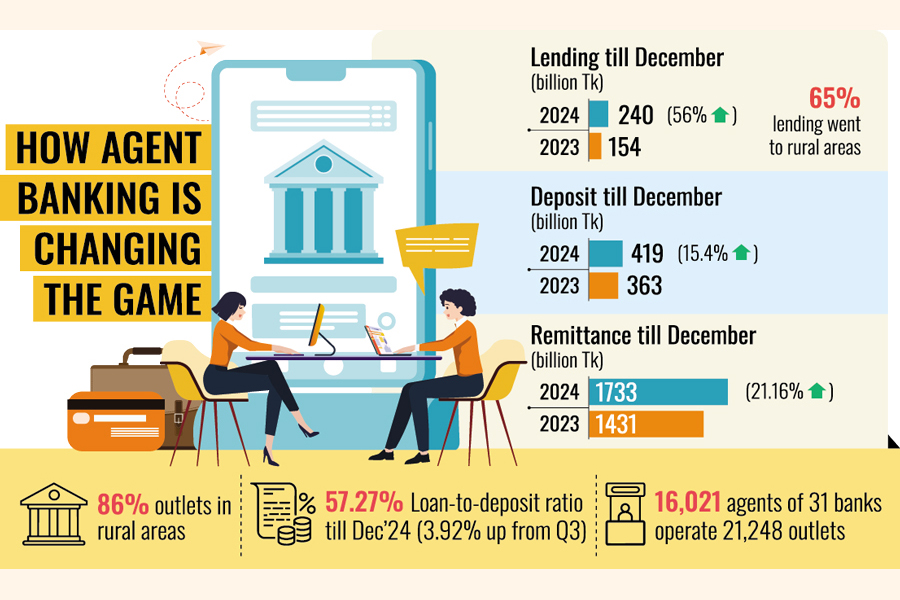
Published :
Updated :

Agent banking continues changing the rural socioeconomic landscape with formal credit inflow, deposit netting, and injection of inward remittance, marking a remarkable increase in the least-developed regions.
Since access to finance is one of the key challenges facing financial inclusion, lending through agent banking is explicitly beneficial to rural customers.
Banking on this facility of easy access to the stakeholders, the operations of agent banking recorded a sharp growth in the fourth quarter (Q4) of 2024.
At the end of December 2024, lending through agent banking rose by around 56 per cent year on year to reach Tk 240.283 billion. The volume of loans disbursed till December 2023 was Tk 154.083 billion.
Around 65 per cent of the lending went to the rural areas where the scope for availing formal credit was thin even several years ago, according to the quarterly report on agent banking released by the Bangladesh Bank (BB) on Monday.
On the other hand, the volume of deposits grew by 15.40 per cent to stand at Tk 419.558 billion at the end of December 2024 from Tk 363.581 billion in the corresponding period of the previous year.
Agent banking also plays a vital role in bringing in remittances from expatriate Bangladeshis as the data showed a 21.16 per cent increase at the end of December 2024. Agent banking networks channelled inward remittances of Tk 1.733 trillion (Tk 1,733 billion) in that period, up from over Tk 1.431 trillion (Tk 1,431 billion) at the end of December 2023.
There are 21,248 outlets operated by 16,021 agents of 31 commercial banks across the country and around 86 per cent of the outlets are located in rural areas, according to the central bank statistics.
Seeking anonymity, a Bangladesh Bank official said the loan-to-deposit ratio in agent banking was 57.27 per cent in Q4 of 2024, up 3.92 per cent from the previous quarter, indicating investments through agent outlets are gradually getting a stronger tailwind.
"Agent banking plays an instrumental role in reshaping the socioeconomic activities in rural areas by especially empowering women, once the most neglected segment in villages," he said.
The central bank introduced agent banking in 2013 to provide a safe alternative delivery channel of banking services to the under-served population, who generally live in remote locations that are beyond the reach of formal banking networks.
Customers can avail various banking services, including deposits, loans, remittances, and payment services (such as utility bills, taxes, and social safety benefits), through agent banking outlets.
Managing Director and Chief Executive Officer of Dutch-Bangla Bank Limited (DBBL) Abul Kashem Md Shirin said his bank received more than 50 per cent of remittances through the agent banking window. "That shows how important an instrument it is for our bank."
"Another important factor is over 50 per cent of agent banking clients are women, and the number is growing gradually. Agent banking services are very cost-effective as well," he said.
Agent banking is not only helping the financial inclusion mechanism flourish but also facilitating business growth in remote areas, the experienced banker added.
jubairfe1980@gmail.com


 For all latest news, follow The Financial Express Google News channel.
For all latest news, follow The Financial Express Google News channel.